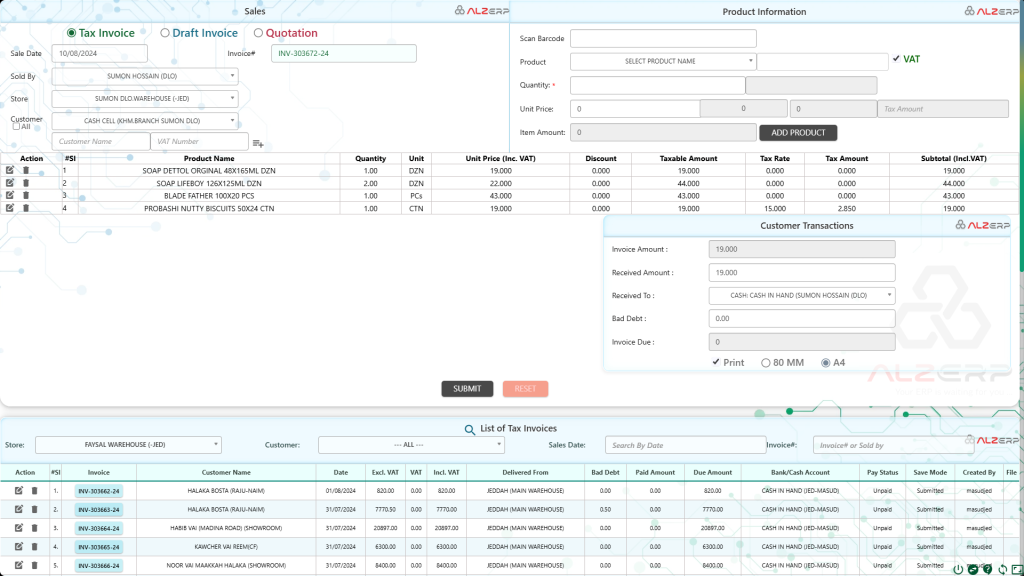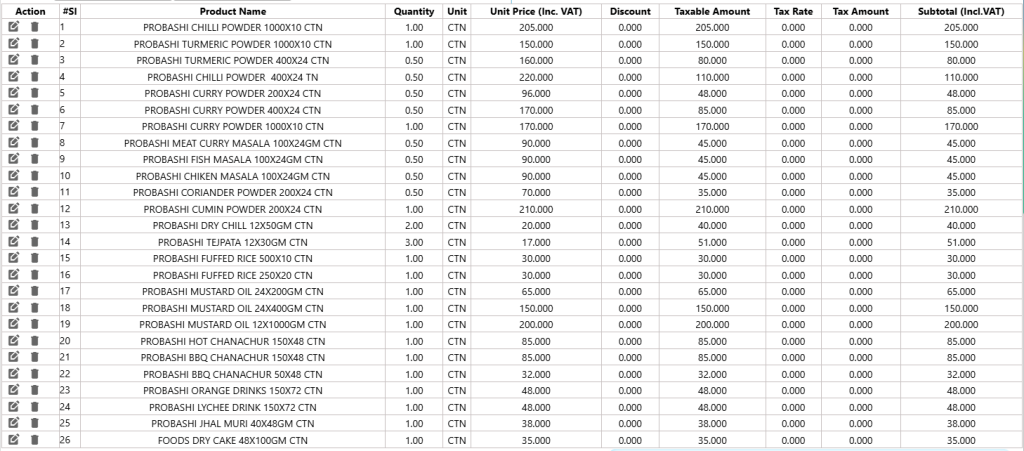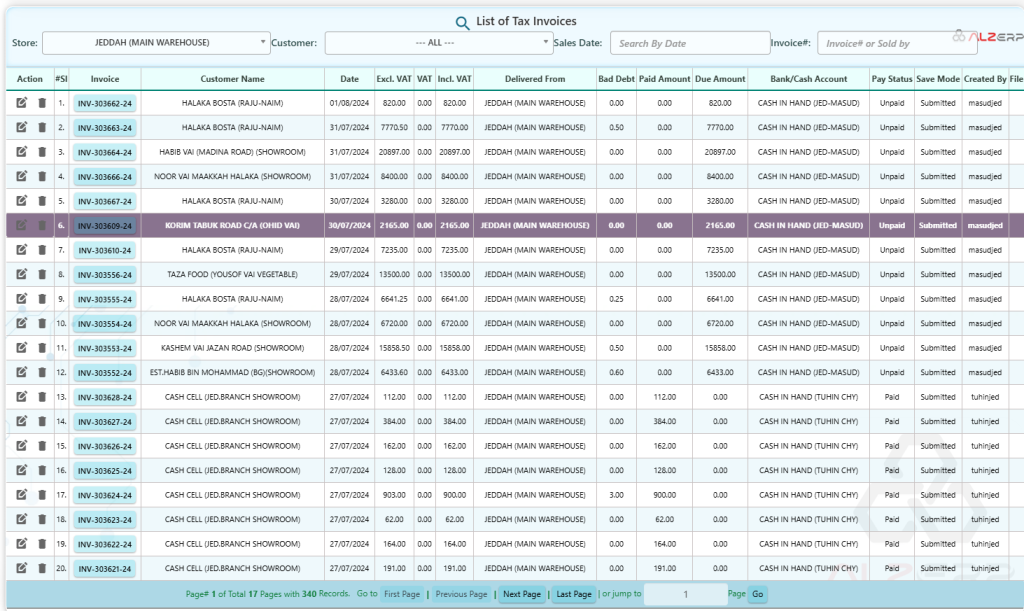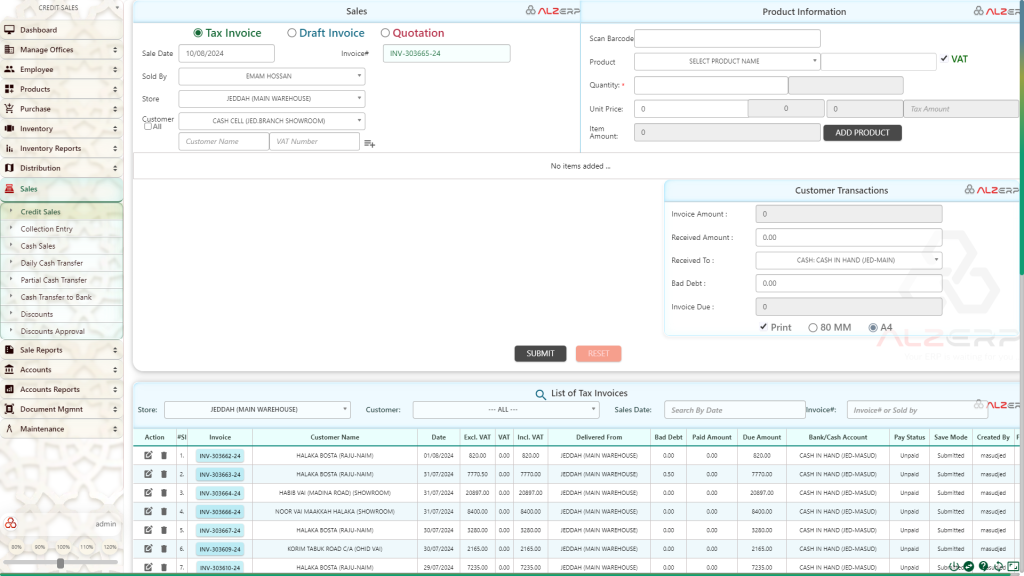ALZERP’s cloud-based sales management system is a comprehensive solution designed to streamline and optimize sales operations for wholesale and retail businesses of all sizes, from small startups to large enterprises. Our software empowers sales teams to effectively manage the entire sales lifecycle, from lead generation to order fulfillment.
By combining sales order management, quotation generation, and invoicing, ALZERP provides a seamless sales process. Our system also offers robust inventory management and customer relationship management (CRM) features to ensure efficient stock control and customer satisfaction.
Leverage advanced sales analytics and forecasting tools to make data-driven decisions, identify sales trends, and optimize sales strategies. Our software also supports sales commission management and sales territory management for effective performance tracking and compensation.
Experience the power of cloud-based multi-sales management with ALZERP. Our system is designed to be intuitive and user-friendly, allowing you to focus on growing your business while we handle the sales management complexities.
Key features include:
- Sales order processing
- Quotation management
- Invoicing
- Inventory management
- CRM
- Sales analytics
- Sales forecasting
- Sales commission management
- Sales territory management

The Sales Management Form in ALZERP Cloud ERP software is a user-friendly interface designed to streamline and manage the sales process efficiently. It combines flexibility, detailed tracking, and automation to cater to various business needs, whether for wholesale or retail operations. Here’s a detailed explanation of the form and its components:
1. Sales Master Interface: #

- Transaction Type Selection:
- Radio Buttons: Users can choose between creating a Tax Invoice, Draft Invoice, or Quotation, depending on the nature of the transaction.
- Date Field: The date of the sale or quotation is automatically populated (e.g., 10/08/2024), but can be manually adjusted if needed.
- Invoice Number: The system generates a unique invoice number (e.g., INV-303672-24) to ensure proper tracking and record-keeping.
- Sold By: Identifies the salesperson handling the transaction (e.g., SUMON HOSSAIN). This helps in tracking performance and accountability.
- Store Name: Specifies the store or warehouse from where the sale is being processed (e.g., SUMON DLO. WAREHOUSE).
- Customer: The customer’s name or entity is selected (e.g., CASH CELL), crucial for customer management and reporting.
2. Product Information Section: #

- Product Selection:
- Barcode Scanning: Products can be quickly added to the sales cart by scanning their barcodes.
- Dropdown List: Alternatively, products can be selected from a dropdown list if barcode scanning is not available.
- Unit Name: Displays both wholesale and retail unit names, allowing flexibility in sales pricing.
- Quantity: Users can input the quantity of the product being sold, with a simultaneous display of available stock quantity to avoid over-selling.
- Unit Price: The price per unit is displayed, which could differ based on whether the sale is wholesale or retail.
- Discount: If applicable, discounts are applied either as a percentage or a fixed amount, which is predetermined in the product setup.
- Tax Amount: The system automatically calculates the tax based on VAT settings in the product setup and the current sales settings. This ensures compliance with local tax regulations (e.g., VAT in KSA).
- Item Amount: The total amount for the item is calculated based on the quantity, unit price, discount, and tax.
- Add to Grid: Once the product information is completed, the item is added to the sales cart (or grid), where multiple products can be listed.
Data in Cart: #

- The grid displays items added to the cart, with detailed information for each product:
- #Sl: Serial number of the product.
- Product Name: Full name of the product (e.g., SOAP DETTOL ORIGINAL 48X165ML DZN).
- Quantity: Number of units being sold.
- Unit: The measurement unit (e.g., DZN for dozens).
- Unit Price (Inc. VAT): Price per unit, including VAT.
- Discount: Any discount applied.
- Taxable Amount: The amount subject to tax.
- Tax Rate: The applicable tax rate.
- Tax Amount: The calculated tax based on the taxable amount.
- Subtotal (Incl. VAT): Total amount for each product, including VAT.
3. Customer Transactions Section: #

- Invoice Amount: Displays the total amount due for the invoice.
- Received Amount: The amount received from the customer is entered here.
- Received To: Selects the method of payment (e.g., Cash or Bank), and specifies the account where the money is received (e.g., CASH IN HAND – SUMON HOSSAIN (DLO)).
- Bad Debt: Any bad debt can be noted here if a portion of the invoice is being written off.
- Invoice Due: Shows any outstanding balance that the customer still owes.
- Auto-Print Option: If checked, the system automatically prints the invoice upon submission. Users can choose the print format (e.g., 80mm or A4 paper).
- Submit Button: Finalizes the transaction, whether it’s a sales entry, draft, or quotation. The system processes and records the sale in the database.
4. Sales History and Invoice List: #

- Search Functionality: Users can search for previous invoices using various filters:
- Store Name: Filter by the store or warehouse.
- Customer Name: Search by the customer associated with the transaction.
- Sales Date: Search by the date of the invoice.
- Invoice Number or Sold By: Allows for detailed searches using the invoice number or the salesperson’s name.
- The list displays past invoices with all relevant details, such as:
- Invoice: Invoice number.
- Customer Name: Name of the customer (e.g., HALAKA BOSTA).
- Date: Date of the transaction.
- Excl. VAT: Amount excluding VAT.
- VAT: VAT amount applied.
- Incl. VAT: Total amount including VAT.
- Delivered From: The warehouse from which the goods were delivered.
- Bad Debt: Any amount written off.
- Paid Amount: Amount received.
- Due Amount: Outstanding balance.
- Bank/Cash Account: Account where the payment was received.
- Pay Status: Indicates whether the invoice is paid or unpaid.
- Save Mode: Whether the invoice was submitted, drafted, or quoted.
- Created By: User who created the invoice.
- File: Attached files, if any.

Here’s a detailed breakdown of its features and functionalities:
1. User and Role-Based Permissions: #
- Customizable Access Control: Administrators can assign specific permissions based on user roles, allowing tailored access to various sales functions.
- Feature-Specific Permissions: Control access to features like sales entry, editing, quotations, and draft sales. This ensures that users only interact with the functionalities necessary for their role.
2. Multi-Sales System: #
- Diverse Sales Operations: The system supports multiple types of sales entries, including direct sales, sales drafts, and sales quotations.
- Flexible Editing: Sales entries can be edited as needed, with permissions set to restrict who can make these changes.
3. Cash and Credit Sales: #
- Product Selection and Barcode Scanning: The system supports both manual product selection and barcode scanning, making it versatile for different sales environments.
- Payment Flexibility: Allows for both cash and credit sales, accommodating various customer preferences.
4. VAT and Non-VAT Sales: #
- Compliance with KSA ZATCA Guidelines: The system is fully aligned with Saudi Arabia’s tax regulations, ensuring that VAT and non-VAT sales are managed accurately.
- Automated Tax Calculations: VAT is automatically calculated based on product setup and sales settings, minimizing errors and ensuring compliance.
5. Inventory and Accounting Integration: #
- Real-Time Inventory Updates: Sales are directly linked to inventory management, ensuring that stock levels are always up-to-date.
- Seamless Accounting: Sales transactions are automatically recorded in the accounting system, providing real-time financial data.
6. Warehouse and Salesman Management: #
- Multi-Warehouse Selection: Sales can be processed from any warehouse assigned to the user, providing flexibility in product sourcing.
- Salesman Selection: Assign specific salesmen to transactions, allowing for performance tracking and accountability.
7. Customer Territory Management: #
- Territory-Based Sales: Sales representatives can select customers from different territories, streamlining the sales process for businesses with geographically dispersed clients.
8. Mobile and Small Device Compatibility: #
- Versatile Device Support: The system is optimized for use on various devices, including mobile phones and tablets, making it accessible for on-the-go sales.
9. Unlimited Product Handling: #
- Scalability: The system can handle an unlimited number of products without compromising performance, making it suitable for businesses of any size.
10. Customizable Invoice Printing: #
- Multiple Format Support: Print invoices in various formats, including 80mm POS printer papers and A4 size, with options for including a ZATCA QR code and company branding.
- Customer Communication: Invoices can be exported as PDFs, printed, or delivered directly to the customer’s WhatsApp number.
11. Sales Master Interface: #
- Comprehensive Sales Entry: The interface allows for easy selection of products, application of discounts, and automatic tax calculations.
- Detailed Product Information: Each item added to the sales cart displays detailed information, including unit price, quantity, discounts, and tax amounts.
12. Customer Transactions Management: #
- Flexible Payment Recording: Record payments received, whether through cash or bank transactions, and track any outstanding amounts or bad debts.
- Automatic Invoice Generation: Automatically generate and print invoices upon transaction submission, with customizable print settings.
13. Sales History Tracking: #
- Searchable Sales Records: Easily search and filter sales invoices by store name, customer, date, or invoice number.
- Detailed Sales Data: The sales history provides a comprehensive overview of each transaction, including amounts excluding VAT, VAT amounts, payment status, and more.
14. Additional Customizable Features: #
- Sales Without Stock: Allow sales transactions even when the product is out of stock, based on user permissions.
- Remarks and File Uploads: Include additional notes or upload files related to the sale, as required.
- Cost and Sales History Display: Show product purchase costs and the last sales rate with date, enhancing decision-making during sales.
15. Reporting and Analytics: #
- Real-Time Sales Data: The system generates real-time reports on sales performance, helping businesses make informed decisions.
- Custom Reports: Generate reports based on specific criteria, such as sales by store, customer, or salesman, for deeper insights.
#
ALZERP’s Sales Management system is designed to simplify and enhance the sales process, offering flexibility, real-time data integration, and comprehensive control over sales operations. Whether for a small business or a large enterprise, the system adapts to meet the needs of various sales environments, ensuring efficient and accurate sales management.
The Sales Management Form in ALZERP Cloud ERP software is designed to simplify the sales process while offering detailed controls and reporting capabilities. It’s a versatile tool that adapts to different sales environments, ensuring accurate transaction processing, inventory management, and compliance with local regulations like VAT in Saudi Arabia. The system’s flexibility in handling product information, customer transactions, and sales history makes it a powerful solution for businesses of all sizes.
Sign up for your free lifetime account of Cloud ERP Software and start transforming your business today!
– Create an account now –






